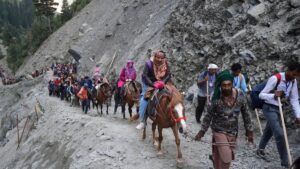Table of Contents
Congress general secretary Jairam Ramesh highlighted that women entering the workforce as salaried or self-employed individuals are earning less than they did six years ago.
Despite the PLFS report 2023, showing a remarkable increase of 4.2%, the female labour force participation rate in India remains low at 37%. This low FLFPR is a big threat to India’s demographic dividend. There is an urgent need to further increase female labour force participation in the productive sectors to help India achieve the dream of becoming a developed nation by 2047.
In this comprehensive article, you will come across the following –
- Key data on Female labour force participation in India
- Analysis of the reasons for Low Female labour force participation rate (FLFPR)
- Solutions to increase this FLFPR with examples and case studies
- Relevant Prelims & Mains Practice Question
Key Facts about Female Labour Force Participation Rate (FLFPR)
Present status: In India, the Female Labour Force Participation Rate (FLFPR) has shown a gradual increase, yet remains substantially lower compared to developed countries.
- 2022-23: 37%
- 2021-22: 32.8%
- 2020-21: 32.5%
- 2019-20: 30%
- 2018-19: 24.5%
Situation in North vs South: Contrary to expectations based on high literacy rates and women empowerment in the southern states has not translated into a higher Female labour Force Participation rate.
- The average FLFPR in five southern states (Tamil Nadu, Karnataka, Telangana, Andhra Pradesh, Kerala) is 13% less than in five northern states (Himachal Pradesh, Rajasthan, Chhattisgarh, Madhya Pradesh, Jharkhand).
International comparison: The World Bank’s data indicates that Indian women’s engagement in the formal economy is one of the lowest globally, ranking above only a few countries in the Arab world in terms of FLFPR.
Decline in Real Wages for Women Workers
- Increase in LFPR: The women’s Labour Force Participation Ratio (LFPR) increased from 27% in 2017-18 to 41.7% in 2023-24.
- 84% of this increase is attributed to self-employed women, many of whom are engaged in unpaid family work.
- Rural Women Driving the Increase: The rise in LFPR is primarily driven by rural women, whose participation is attributed to economic distress.
- The proportion of rural women in self-employment increased from 7% in 2017-18 to 73.5% in 2023-24, while for urban women, it went from 34.8% to 42.3%.
- Unpaid family work among women rose from 7% (2017-18) to 36.7% (2023-24).
- Decline in Women’s Real Income:
- Self-employed women’s real average monthly wage dropped by ₹3,073 (35%) between 2017-18 and 2023-24 after adjusting for inflation.
- Salaried women’s real wages declined by ₹1,342 (7%) during the same period
Reasons for Low Female Labour Force Participation
- Informal Employment: High Informalisation characterized by the absence of formal contracts or social security, prevents women from participating actively in the labour market.
- About 88% of women employed in industries and 71% in services are informal (International Labour Organization 2018).
- Lack of alternative opportunities: In India, the scarcity of alternative employment options in manufacturing, suppresses their labour force participation.
- For instance, the automotive industry, employs predominantly male workers, excluding a large proportion of potential female employees.
- Workplace Bias: India experiences one of the most pronounced gender disparities in wages, as highlighted in the Economic Survey of 2018.
- Discriminatory pay practices and the ‘glass ceiling’ phenomenon create a challenging environment for women, impacting their decision to engage in professional work.
- Occupational Gender Stereotypes: Societal norms dictate specific job roles known as ‘Pink Jobs’ for women, confining them to sectors like nursing, teaching, and gynaecology.
- This limitation hinders women’s participation in male-dominated fields such as engineering and defence, where they face both overt and subtle barriers.
- Cultural Norms and Domestic Roles: Traditional expectations regarding women’s roles in unpaid care, childcare, and household tasks significantly restrict their participation in the formal workforce.
- In many patriarchal societies, societal norms discourage or prevent women from pursuing careers post-marriage, further diminishing the FLFPR.
- Household Income and Employment Choice: The rise in household incomes provides women with the financial flexibility to choose not to engage in formal employment, focusing instead on domestic duties or personal interests.
- National Sample Survey Office (NSSO) suggests that higher family incomes correlate with lower female workforce participation rates.
- Safety and Harassment Concerns: The prevalent issues of violence against women and workplace harassment, particularly in night-time roles, act as significant deterrents, limiting women’s participation in the labor force.
- The #MeToo movement in India showed the wide range of harassment women face in their respective workplaces.
- Mismatch Between Education and Employment: Despite higher educational attainments among women, there’s a lack of suitable job opportunities.
- g. despite the increasing female graduates in STEM fields, their representation in related industries needs to improve due to the scarcity of appropriate roles.
- Legal Employment Restrictions: Certain state laws restrict women from working in specific hazardous sectors, impacting their employment options.
- For instance, laws in some states prohibit women from working in mines or certain factory roles, limiting their employment choices in these sectors.
- Political Underrepresentation: The low representation of women in India’s political landscape, with only 14.4% of seats in the Lok Sabha occupied by women, reflects a gender gap in policy-making.
Significance of Enhancing Female Labour Force Participation
- Economic Growth: The International Monetary Fund (IMF) estimates that gender parity in the workforce could boost India’s GDP by 27%.
- Combating Poverty: Women’s participation in formal work can address the trend of feminization of poverty, characterized by women’s overrepresentation in low-paid, informal work.
- Impact on Health: Increased female employment in formal sectors is correlated with better health outcomes like lower Infant Mortality Rate (IMR) and Maternal Mortality Rate (MMR).
- A study in Sri Lanka observed a direct correlation between women’s employment and improved healthcare access, leading to a decrease in IMR and MMR.
- Financial Independence: Earning their own income enhances women’s self-confidence and decision-making power in households, especially in areas like family planning.
- In Kerala, higher women’s employment rates have been linked to their increased role in household decisions (Centre for Development Studies).
- Economic Stability: Dual-income families, resulting from women entering the workforce, enhance household income and economic stability.
- Dual-income households showed better resilience in economic downturns compared to single-income households (McKinsey Global Institute report).
- Innovation and Creativity: A diverse workforce, including women, brings varied perspectives, leading to increased creativity and innovation in the workplace.
- Companies with more diverse management teams have 19% higher revenues due to innovation (Boston Consulting Group Study).
- Equity in Pay: Increasing women’s participation in formal sectors can help address the gender wage gap.
- Countries with higher female labour force participation tend to have a lower gender pay gap (Global Gender Gap Report 2020).
- Women Entrepreneurs: Higher participation in the workforce can encourage women to venture into entrepreneurship, contributing to economic diversity.
- The success of women-led startups in India, like Nykaa and Zivame, underscores the potential of women entrepreneurs in boosting the economy.
- Changing Social Norms: Employment of women in diverse sectors can challenge and change traditional gender roles, promoting gender equality.
- The participation of women in sectors traditionally dominated by men in Nordic countries has helped to foster a change in societal norms.
- Impact on Children’s Education: Working women are more likely to invest in their children’s education, leading to better educational outcomes.
- UNESCO reports that children of employed mothers in developing countries are more likely to be enrolled in school and achieve higher educational levels.
- Improved Family Health: Women tend to spend more of their income on family health, leading to overall improved health outcomes.
- A research in Bangladesh showed that families with working women were more likely to have better nutritional status and healthcare access.
- Economic Dependency: An increased female workforce can lower the dependency ratio in a population, easing economic pressures.
- As per a UNFPA report, countries with higher female labor participation often have lower dependency ratios, contributing to economic growth.
- Enhanced International Standing: A higher FLFPR can improve India’s image as an inclusive and progressive economy.
- The World Economic Forum’s Global Competitiveness Report often cites gender parity as a key factor in a country’s overall economic competitiveness.
Government Initiatives For Female Labour Force
| Initiative | Description |
| Maternity Benefit (Amendment) Act, 2017 | Enhanced paid maternity leave to 26 weeks. Option for remote work post-leave on mutual agreement. Mandatory crèche facilities for establishments with 50+ female employees. |
| Anganwadi Centers (Integrated Child Development Services – ICDS) | Offers nutritional support, safe environments, and early childhood education, aiding women in rejoining the workforce post-childbirth. |
| National Food Security Act (NFSA), 2013 | Provides affordable food and grants cash transfers of at least INR 6,000 to pregnant and lactating mothers, reducing the necessity for early work return. |
| Stand Up India Scheme | Facilitates bank loans ranging from INR 10 lakh to 1 crore for new enterprises in various sectors, specifically targeting SC/ST/Women entrepreneurs. |
| The Sexual Harassment of Women at Workplace Act, 2013 | A legal framework to protect women from sexual harassment at work, promoting a safer and more equitable working environment. |
Way Forward
- Policy and Legal Reforms: Revise labour laws like India’s night work restrictions, drawing inspiration from Sweden’s successful labour law amendments for increased women’s participation.
- Flexible Work Arrangements: Promote work flexibility, akin to Best Buy’s ROWE (results-only work environment) program, to help women balance work and family.
- Enhanced Childcare Facilities: Expand affordable childcare, following Sweden’s model, to facilitate women’s employment.
- Vocational Training Programs: Implement targeted training programs, mirroring the European Union’s “New Skills, New Jobs” initiative, to upskill women for emerging job markets.
- Women’s Entrepreneurship Support: Foster women’s entrepreneurship with credit access and mentorship, as exemplified by Bangladesh’s Grameen Bank model.
- Gender-Neutral Recruitment: Adopt unbiased hiring policies like Salesforce to ensure a diverse workforce.
- Equal Pay Initiatives: Enforce equal pay laws, drawing from Iceland’s equal pay certification approach, to bridge the gender wage gap.
- Improved Safety Measures: Enhance public and workplace safety, similar to Delhi’s ‘Pink Ticket’ scheme, to encourage women’s workforce participation.
- Gender Sensitization Campaigns: Run awareness programs to challenge stereotypes, using Norway’s gender equality education as a model.
- Government-Private Sector Collaboration: Develop public-private partnerships, akin to Germany’s ‘Frauen Machen Neue Technologien’, to create job opportunities for women.
- Workforce Re-entry Programs: Introduce re-entry initiatives like Goldman Sachs’ ‘Returnship’ programs to support women returning to work after career breaks.
- Social Security for Informal Workers: Extend social security to informal sector women, inspired by Brazil’s Bolsa Familia program.
- National Awareness Campaigns: Launch campaigns to promote women’s workforce importance, similar to the UN’s ‘HeForShe’ initiative.
- Increased Political Representation: Ensure women’s representation in policymaking, as demonstrated by Rwanda’s gender parity in parliament.
- International Collaborations: Engage in global partnerships for sharing best practices in women’s labour force participation, like the Canada-UK Women’s Empowerment Initiative.


 Operation Shiva 2025: Indian Army’s Ma...
Operation Shiva 2025: Indian Army’s Ma...
 World Youth Skills Day 2025, Theme, Hist...
World Youth Skills Day 2025, Theme, Hist...
 President Murmu Nominates Four Members t...
President Murmu Nominates Four Members t...





















